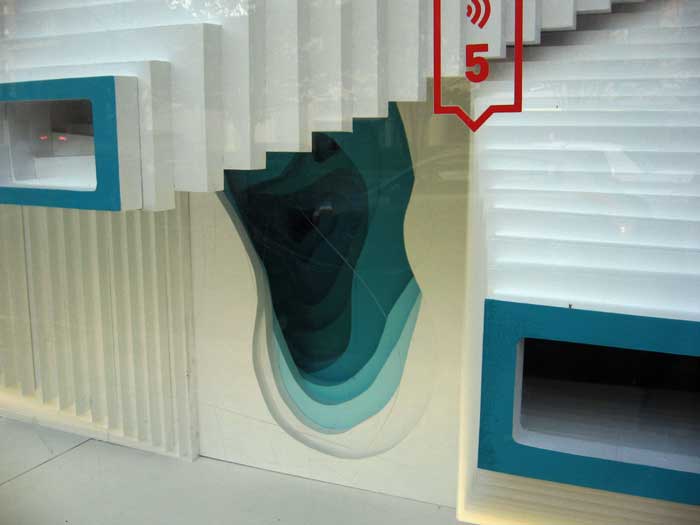A pile of stapled papers with curly edges bearing the wear of travel and messy annotated exhibit explanations set me apart from the rest of the foot traffic speeding past a row of storefronts off of Ashland and Milwaukee. Nary a minute passed when I was approached for explanation. “What is this place?” asked a duo of older men, their hands holding steaming to-go cups of coffee.
“Well,” I groaned, “this is an art exhibit and we’re supposed to—” I paused to find my place in my scroll of parchment. The men looked on as I read aloud: “‘Observe and interact with the installation through visual and sonic exchanges with a series of viewfinders presented by a fictional entity, Store/Store.’”
“Oh,” went the men. “Store/Store”? We all paused in silence and looked in earnest at what was before us. Then we all looked at each other and smiled.

“Yeah,” I offered. “Hopefully there’s some fine print here I’m missing.” The men laughed and went on their way. The fine print never materialized as I peered into the viewfinders and dialed a number splayed all over the exhibit promising the “sonic exchanges.” My sonic experience never materialized either. For want of a code, I hurriedly scanned the storefront. Nothing. Unable to present the necessary digits allowing what would have hopefully been the key to uncovering the “suspicion that there are hidden possibilities and narratives latent within the landscape of the street,” I hung up.
“What is this?” a woman called out.
“Art,” I murmured.
“I thought it was an eye doctor’s office,” offered her companion. They both giggled and walked away.
I returned to the viewfinders. Was I missing something? I looked into yet another viewfinder. Then I took the obligatory steps backward to take it all in once again. All I could think about was how the openings looked like one of those models in the doctor’s office of an inner ear or some other body cavity. Maybe that’s what the woman was thinking, too. Body cavity exam. Eye socket. Viewfinder. Glasses. This was my first experience of the WPB (Wicker Park Bucktown) Make Believe Vacant Storefront Art Competition…or so I thought.

“Take Me With You” was the second installation. With all the creativity of a meat locker, photos hung on hooked ribbons dangling from the ceiling. Used cameras and photo scraps lined the floor of the storefront. The actual store was not only vacant but heavily soiled with stains and a helpless used Windex bottle showing from the darkness. It would take more than make believe for me to be moved to some sort of artistic catharsis. So I moved on.
Robots were involved in the third installation. I moved on. Furniture happened on the fourth. I moved on. Flying and working and artichokes and slowness all met me moving on as I worked my way through the not-so-vacant fronts. By this time, my crumpled papers deterred anyone curious enough to pay attention. By this time, my papers deterred even me from my make belief. And then, as they say, it happened.
I threw the papers away. The papers, it would seem, were keeping me from my experience, my Cameron Frye moment when I stare into the deep of the art and only to see a different version of myself reflected back. I ran back to the Artichoke, an exhibit I later voted as my choice for first place.
Striking in its use of space, I dismissed it all too quickly with my initial run-through because I couldn’t make the explanation work for me. I couldn’t see “inner relations between independent business and we who depend on them.” I missed the “spatial rhythm” involved in deconstructing artichoke layers in a boutique. And I really wanted to see all of this. Instead, I saw an ingenious way to precipitate negative space into something pernicious and hostile that literally broke through the storefront and protruded out onto the sidewalk. Never before had I seen a storefront used – violated –in this way.
A return to the exhibits after my Artichoke epiphany didn’t bring about in me the Platonic sublime moment for all of them, but the moment was not lost. I lingered there in this idea of the storefronts as perforated. Like breaking the fourth wall in theater and looking directly at the audience, Artichoke ventured out past the boundary. Artichoke did something unexpected that I could visually connect with. Some of the other exhibits lost sight of just what was capable for those passers-by, hampered as they might or might not be with messy papers and distracted minds.
New York Times bestselling author Amy Krouse Rosenthal hung money from leaves on a tree and quickly walked away to see what would happen. Violinist Joshua Bell played some of the best music ever written in the history of the earth on his three million dollar Stradivarius for one hour in a busy train station. In either case, barely anyone noticed. I was thinking about these instances of unfortunate distraction while paying such attention to these storefront displays. I couldn’t help think that even from a storefront, a place where people are conditioned to look, the best art can still be missed if you don’t first put down your papers and look.
To see more photos of my WPB Make Believe Art Crawl experience, visit my Flickr Photostream.
WPB Make Believe Vacant Storefront Art Competition
October 1-29
Visit web site for locations
773.235.6385
http://makebelieve.wegotitinwpb.com
When: July 15 – Oct. 29, 2010
Viewing: all installations will be exclusively viewable from the street, creating a 24/7 open-gallery that you can view at any time
Voting: you can start casting your online ballots July 15th and they must be in by October 27th